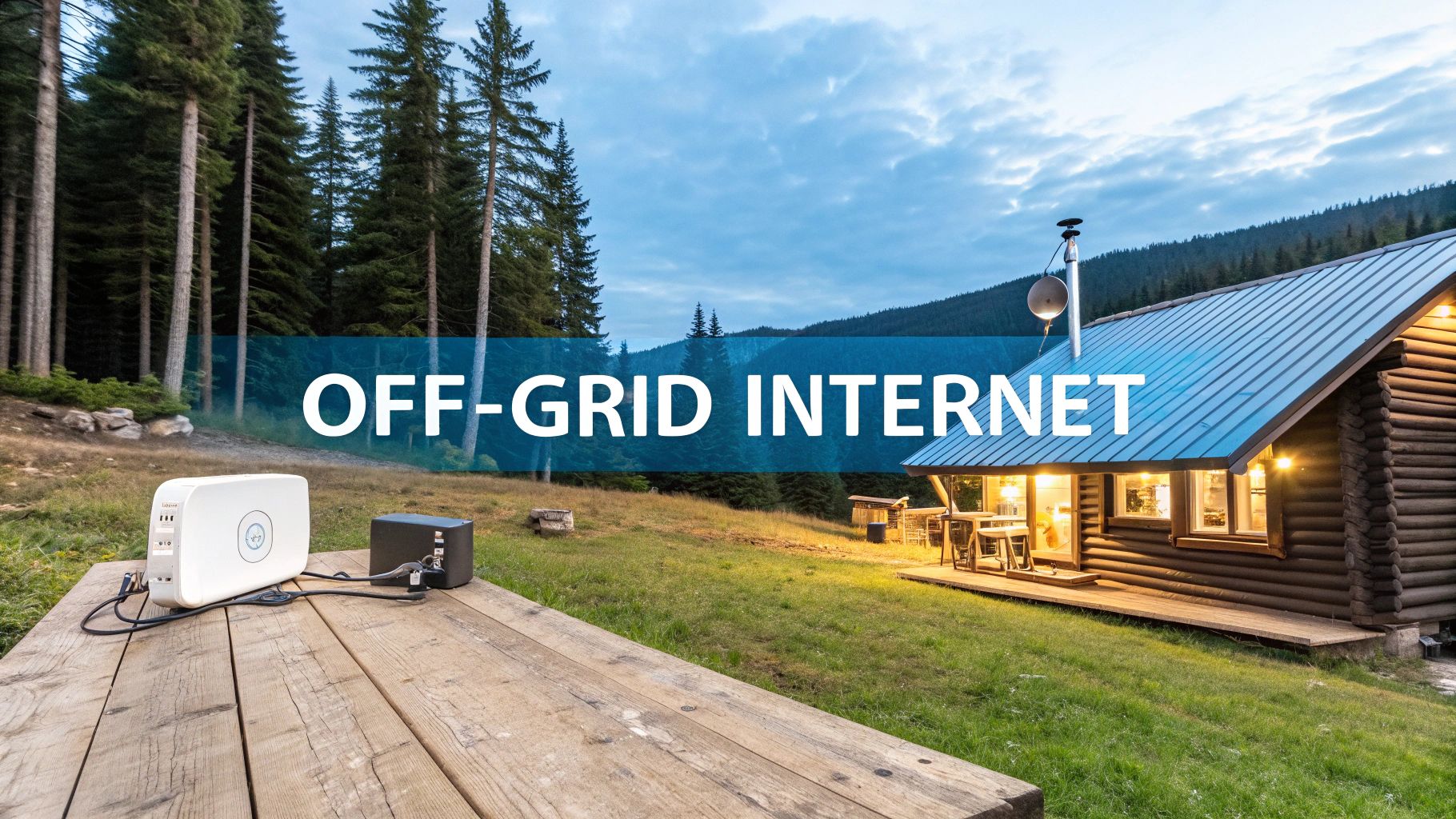

· By James
Top Off The Grid Internet Options for Remote Connectivity
The dream of off-grid living, be it in a remote cabin, a sustainable homestead, or a traveling RV, no longer means sacrificing your connection to the digital world. The demand for reliable internet far from city infrastructure has driven incredible innovation. Whether you're a remote worker needing stable video calls, a digital nomad uploading content, or simply want to stay in touch with loved ones, staying connected is a modern necessity. But navigating the complex landscape of off the grid internet options can be daunting. From low-Earth orbit satellites to hyper-local mesh networks, the right solution depends entirely on your location, specific needs, and budget.
This guide is designed to cut through the noise. We will break down the 7 most effective methods for getting online when traditional cable and fiber are out of reach. We'll explore the technology, weigh the pros and cons, and provide real-world scenarios to help you find the perfect fit. This philosophy of self-sufficiency often extends beyond just connectivity; for those interested in a fully independent lifestyle, exploring options like making your home energy neutral can provide valuable, parallel insights. Let's dive into the full spectrum of possibilities to keep you connected, wherever your off-grid adventure takes you.
1. Satellite Internet
When you're truly beyond the reach of cell towers and cable lines, satellite internet stands as the ultimate solution for connectivity. This technology bypasses terrestrial infrastructure entirely, using a dish installed at your location to communicate directly with satellites orbiting the Earth. It’s the definitive choice for anyone seeking reliable internet in the most isolated corners of the globe.
How Satellite Internet Works
The process involves three main components: your satellite dish, a satellite in space, and a ground station (or gateway) connected to the global internet. Your dish sends and receives data from an orbiting satellite, which acts as a powerful relay, bouncing the signal down to a gateway. This round trip completes your connection, delivering broadband to your home, RV, or remote worksite.
The key difference in modern satellite internet lies in the satellite's altitude.
- Geostationary (GEO) Satellites: These traditional satellites (from providers like Viasat and HughesNet) orbit 22,236 miles above the Earth. Their fixed position provides consistent coverage but results in higher latency, or "lag," due to the immense distance the signal must travel.
- Low Earth Orbit (LEO) Satellites: Newer constellations, like SpaceX's Starlink, operate much closer to Earth (around 340 miles). This dramatically reduces latency, making LEO systems suitable for real-time applications like video conferencing and online gaming.
Best-Use Cases and Practical Examples
Satellite is one of the most versatile off the grid internet options, ideal for those with no other choice. It excels in geographically challenging environments where laying cables is impossible.
Consider a farmer in rural Wyoming using Starlink to manage smart irrigation systems or a remote mining operation in Australia relying on Viasat for critical communications. It’s also the backbone for emergency responders providing connectivity in disaster zones where terrestrial networks have been compromised.
The following infographic highlights the core differences and capabilities of modern satellite internet systems.
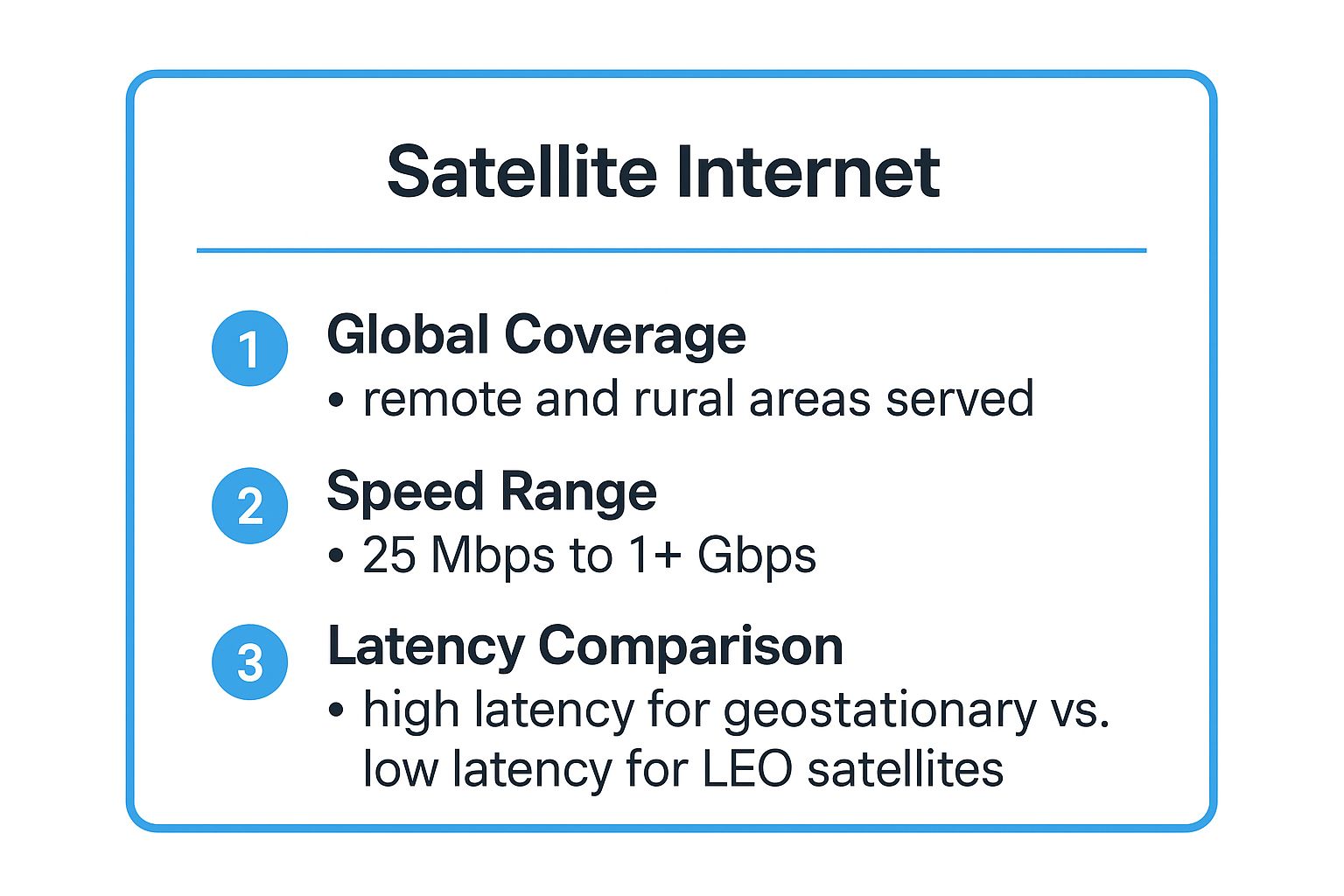
This visual breakdown makes it clear that while satellite offers near-universal coverage, the choice between GEO and LEO providers directly impacts the speed and responsiveness you can expect.
For a deeper dive into how a LEO system like Starlink operates, this video offers an excellent explanation:
2. Cellular Hotspot/Mobile Data
For those who are not completely disconnected from civilization but are still outside the reach of traditional broadband, cellular hotspots offer a flexible and powerful solution. This technology harnesses existing 4G and 5G mobile networks, converting a cellular signal into a reliable Wi-Fi network that can support multiple devices. It’s the go-to choice for digital nomads, RV travelers, and rural homeowners who need dependable connectivity on the move or in areas with limited infrastructure.
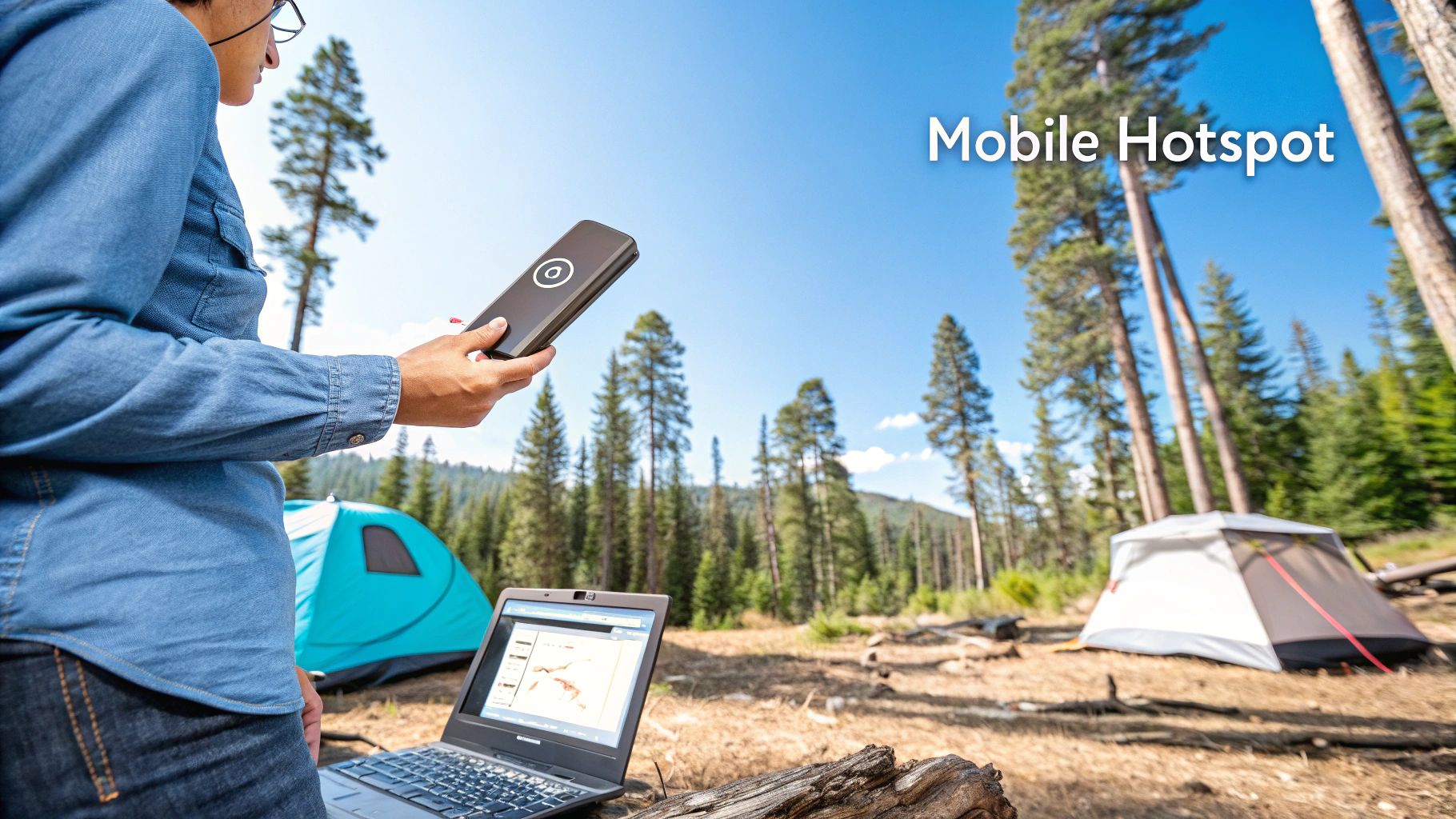
How Cellular Hotspots Work
Cellular internet solutions function by using a SIM card to connect to a mobile carrier's data network, just like a smartphone. This connection is then broadcast as a local Wi-Fi signal that your laptops, tablets, and other smart devices can join. There are a few common ways to implement this:
- Dedicated Mobile Hotspots: These are portable, battery-powered devices like the Verizon Jetpack or NETGEAR Nighthawk M6. They are designed specifically to provide Wi-Fi on the go and often offer stronger performance than a smartphone's built-in hotspot feature.
- Smartphone Tethering: The most accessible option involves using your phone's built-in hotspot capability. It’s perfect for occasional use but can drain your phone's battery and may be subject to stricter data caps from your carrier.
- Cellular Routers: For a more permanent setup, like in a rural home or an RV, a cellular router is ideal. These devices are more robust, support external antennas for improved signal reception, and are built for continuous operation.
Best-Use Cases and Practical Examples
Cellular hotspots are one of the most practical off the grid internet options when a mobile signal is available, however faint. They bridge the gap between complete isolation and full-service areas.
For instance, a construction crew at a new job site can deploy a ruggedized cellular router to establish instant internet for project management tools. Likewise, RV travelers use mobile hotspots to stay connected while exploring national parks, and remote workers in cabins can rely on T-Mobile or Verizon's home internet services, which are powered by their 5G/4G networks. If you plan to travel extensively, it's wise to research options for booking mobile internet abroad to ensure seamless connectivity.
To get the most out of this setup, especially for a fixed location, you may want to explore using a hotspot as your primary home internet. This often involves pairing the device with signal-boosting technology for maximum speed and reliability.
3. Fixed Wireless Internet
Fixed wireless internet bridges the gap between terrestrial and satellite services, offering a reliable broadband connection where cables can't reach. It works by transmitting internet data via radio waves from a ground-based tower to a small antenna or receiver installed on your property. This makes it an excellent alternative when you're just outside the range of traditional cable or fiber but don't need the global reach of satellite.
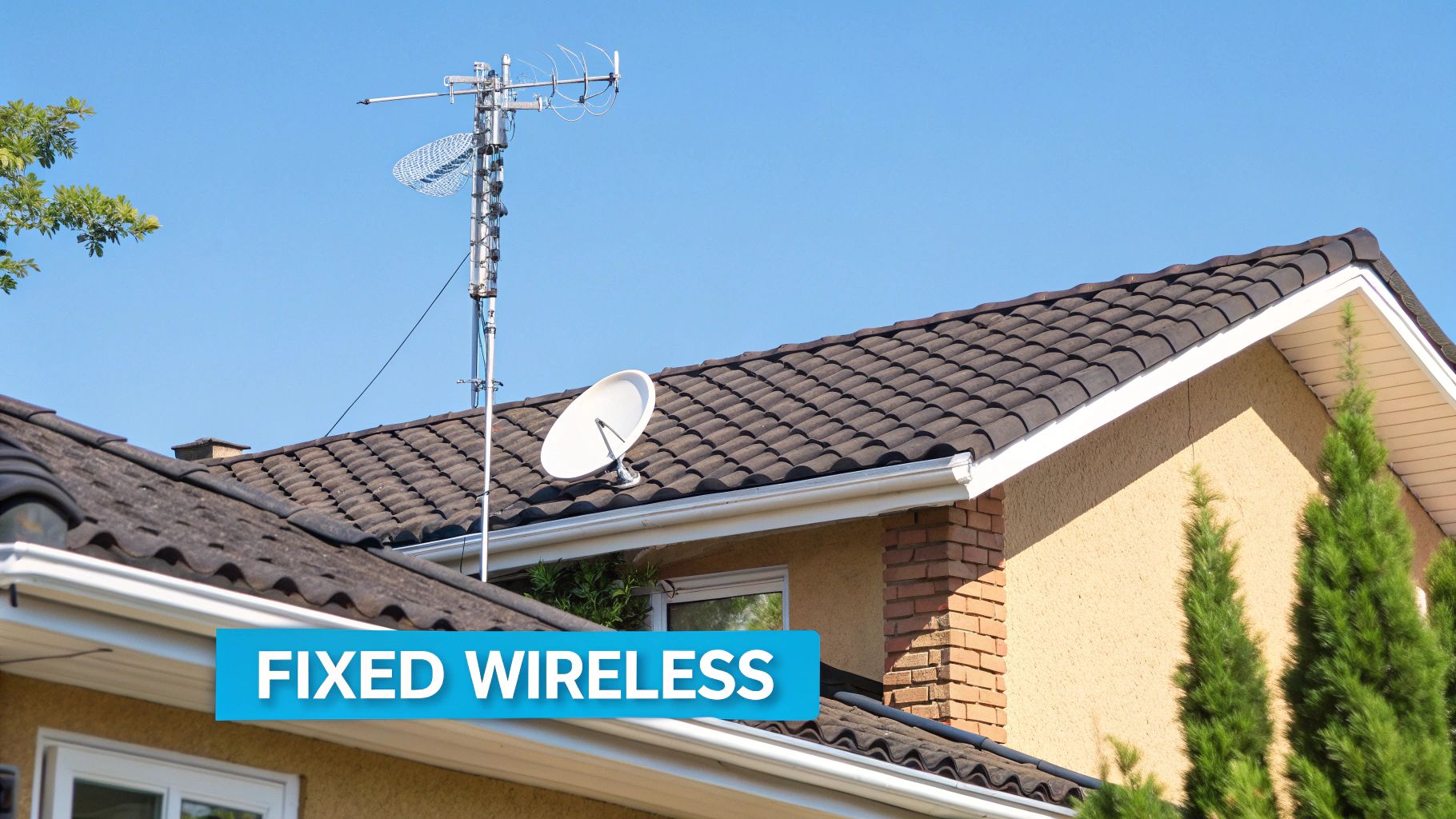
How Fixed Wireless Internet Works
This technology relies on a "line-of-sight" or "near-line-of-sight" connection between a provider's access point (often a tower) and your home receiver. The tower is connected to the internet via a high-speed fiber line. It then broadcasts the signal wirelessly to subscribers within its coverage area, typically a radius of several miles.
Unlike mobile data that connects to any available cell tower, fixed wireless is a stationary, point-to-point connection. This dedicated link generally results in lower latency and more consistent speeds compared to cellular hotspots, making it one of the most stable off the grid internet options for stationary setups.
Best-Use Cases and Practical Examples
Fixed wireless shines in rural and semi-rural settings where terrain or distance makes laying physical cables impractical. It is the go-to solution for many homeowners and small businesses seeking dependable, high-speed internet without the high latency of geostationary satellites.
For instance, farms in Iowa use local wireless ISPs (WISPs) to manage operations and stay connected, while mountain cabins in Colorado can get reliable broadband from providers that specialize in broadcasting signals across valleys. Major providers like Rise Broadband and Nextlink Internet have built extensive networks serving thousands of rural communities across the United States. Before committing to a provider, it's crucial to verify their coverage and ensure a clear line of sight from your property to their tower. You can discover more about the nuances of this technology and how it serves remote locations. Learn more about internet access for rural areas at swiftnetwifi.com.
4. Mesh Network Systems
For communities looking to build their own resilient, decentralized internet, mesh networks offer a powerful and cooperative solution. Instead of relying on a single internet provider, a mesh network creates a web of interconnected nodes (routers) where each node communicates with others in range. This creates a self-healing system that routes data along the most efficient path, providing reliable connectivity even if some nodes go offline.
How Mesh Networks Work
A mesh network operates on a simple yet robust principle: cooperative connectivity. It starts with one or more nodes connected to an internet source, known as a "gateway." These gateway nodes share their connection wirelessly with other nearby nodes. Each of these nodes, in turn, can share the connection with others farther down the line, extending the network's reach organically.
The network’s intelligence lies in its ability to self-manage.
- Decentralized Structure: Data can hop from node to node to reach its destination. If one path becomes congested or a node fails, the network automatically reroutes the traffic through an alternative path.
- Scalability: The network grows stronger and more resilient as more people join and add nodes. Each new user helps extend the coverage area and adds redundancy to the system.
Best-Use Cases and Practical Examples
Mesh networking is one of the most community-centric off the grid internet options, ideal for neighborhoods, rural hamlets, or even RV parks where a group of people wants to share a single, strong internet connection. It’s also a proven model for building grassroots internet infrastructure where traditional providers won't invest.
A prominent example is NYC Mesh, a community-run network providing affordable internet across parts of New York City by placing nodes on rooftops. Similarly, Guifi.net has connected tens of thousands of users in Catalonia, Spain, creating one of the world's largest community-owned telecommunications networks. These projects show how collective action can bridge the digital divide.
To successfully build your own mesh network, consider these key steps:
- Start with a small pilot project to test equipment and coverage.
- Use standardized, compatible hardware for easier maintenance and expansion.
- Plan node placements carefully, aiming for line-of-sight between nodes for the strongest signal.
- Establish clear community governance for managing the network and its costs.
- Equip critical nodes with battery backups to maintain connectivity during power outages.
For a deeper look at the community power behind these systems, this video on NYC Mesh provides great insight:
5. Point-to-Point Wireless Links
When a high-speed internet source is available but just out of reach, a point-to-point (PTP) wireless link can bridge the gap. This solution uses directional antennas and specialized radio equipment to create a private, high-speed connection between two fixed locations, effectively "beaming" internet from a connected site to a remote one. It’s an ideal choice for extending an existing network over significant distances where running a physical cable is impractical or impossible.
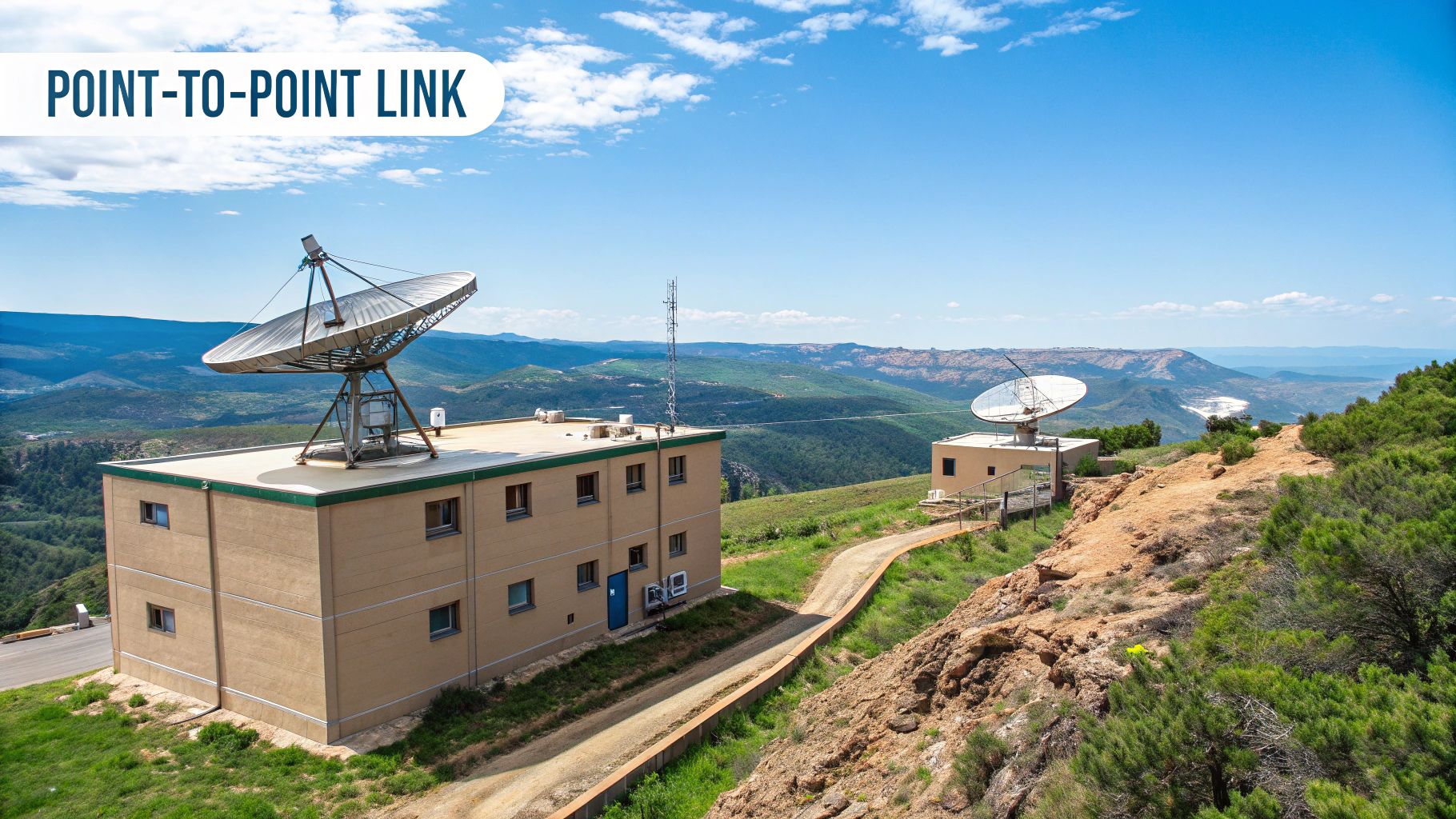
This setup is one of the more technical off the grid internet options, but it offers unparalleled speed and reliability once established.
How Point-to-Point Wireless Works
A PTP link requires two main pieces of hardware: a transmitting radio at the location with internet service and a receiving radio at the off-grid location. These radios, often from brands like Ubiquiti, MikroTik, or Cambium Networks, are mounted high up and aimed directly at each other. The key requirement is a clear, unobstructed line of sight between the two points.
The system works by creating a focused, directional radio beam that carries data between the two antennas. Unlike a standard Wi-Fi router that broadcasts a signal in all directions, a PTP link concentrates the signal into a narrow path. This allows the connection to span distances of several miles while maintaining high bandwidth and low latency, essentially creating a "virtual ethernet cable" through the air.
Best-Use Cases and Practical Examples
PTP links excel where you can access internet nearby but not at your exact location. It's a powerful tool for overcoming the "last mile" connectivity problem in rural and remote settings.
Imagine a farmer whose main house is in a town with fiber internet, but their farm several miles away has no service. They can install a PTP link to beam that high-speed connection directly to the farm, enabling smart agriculture technology and reliable communication. Another example is connecting a main house to a guest cabin across a valley or providing robust internet to a remote construction site by linking it back to a main office in a connected area.
For those considering this powerful solution, it's worth exploring all the details. You can learn more about how to go wireless with this guide to seamless connectivity. This deeper understanding will help you plan a successful deployment.
6. Bonded Internet Solutions
When a single connection isn't enough, bonded internet offers a powerful way to achieve superior reliability and speed. This technology combines multiple different internet connections, like cellular, satellite, and DSL, into a single, robust data stream. It’s the ultimate fallback plan, ensuring you stay online even if one of your primary sources fails.
How Bonded Internet Works
Bonding aggregates the bandwidth from multiple internet sources, essentially "gluing" them together. This is managed by specialized hardware (from companies like Peplink or Cradlepoint) or software (like Speedify). The system intelligently distributes your data packets across all active connections. If one connection drops, the traffic is automatically rerouted through the remaining ones, providing seamless failover without interruption.
This technology allows you to mix and match different connection types for maximum resilience.
- Connection Aggregation: It merges the speeds of all active links. For example, two 50 Mbps cellular connections could be bonded to create a single, faster 100 Mbps pipeline.
- Seamless Failover: If your primary satellite link is disrupted by a storm, the bonding router instantly shifts all data to a secondary 5G cellular connection, keeping your video call or data transfer alive.
Best-Use Cases and Practical Examples
Bonded internet is one of the most dependable off the grid internet options for mission-critical applications where downtime is not an option. It provides the stability needed for demanding professional tasks in unpredictable environments.
Imagine a remote medical clinic combining a Starlink dish with a 5G hotspot to ensure doctors can always access patient records and conduct telehealth appointments. Similarly, mobile news crews use bonded cellular connections from different carriers (like AT&T and Verizon) to guarantee a stable signal for live broadcasts from remote locations. Emergency response teams also rely on this technology to maintain a command center's connectivity in disaster zones where any single network could be compromised.
To make the most of a bonded setup, consider these tips:
- Use Diverse Providers: Combine connections from different carriers (e.g., T-Mobile and Verizon) or technologies (satellite and cellular) to avoid a single point of failure.
- Monitor Each Connection: Regularly check the performance of individual links to identify and address weak points before they become a problem.
- Plan for Data Caps: Be mindful of the different data limits on your combined plans to avoid unexpected throttling or overage fees.
- Invest in Quality Hardware: A reliable bonding router or device from a reputable brand like Peplink is crucial for stable performance and effective traffic management.
7. Ham Radio Packet Networks
For the ultimate in resilient, long-distance digital communication, ham radio packet networks provide a powerful, infrastructure-independent solution. This method uses amateur radio frequencies to transmit digital data, allowing licensed operators to access services like email and bulletin boards through a global network of volunteer-run gateway stations. It is one of the most robust off the grid internet options for when all other systems fail.
How Ham Radio Packet Networks Work
Packet radio functions by converting digital information into "packets," which are then transmitted over amateur radio bands using a modem-like device called a Terminal Node Controller (TNC). A receiving station with a TNC decodes these packets back into readable data. This enables peer-to-peer data exchange or connection to a gateway that links the radio network to the internet.
The most widely used system for this is Winlink, a global radio email service.
- VHF/UHF Packet: This method is used for short-range connections, typically within a 50-mile radius, to a local Winlink gateway (RMS). It offers faster speeds but requires line-of-sight to the gateway.
- HF Packet (High Frequency): For true global reach, HF radio can bounce signals off the Earth's ionosphere to connect to gateways hundreds or thousands of miles away. While slower, it is the go-to for mariners and explorers far from civilization.
Best-Use Cases and Practical Examples
Packet radio excels in situations where reliability and long-range capability are more critical than speed. It's not for streaming video, but it’s a lifeline for essential data communications.
Consider mountaineers on a remote expedition using Winlink to receive critical weather updates or sailors crossing the Pacific Ocean sending daily position reports and emails to family. It's also a cornerstone of emergency communications; groups like ARES (Amateur Radio Emergency Service) use it to coordinate relief efforts when natural disasters knock out conventional internet and phone lines. For these scenarios, it’s not just an option, it's an essential tool.
Off-Grid Internet Options Comparison
| Technology | Implementation Complexity 🔄 | Resource Requirements ⚡ | Expected Outcomes 📊 | Ideal Use Cases 💡 | Key Advantages ⭐ |
|---|---|---|---|---|---|
| Satellite Internet | Low to Medium | Moderate equipment & monthly costs | Wide coverage, 25 Mbps to 1+ Gbps | Remote/rural areas, disaster relief | Global reach, improving speeds |
| Cellular Hotspot/Mobile Data | Very Low | Minimal hardware, cellular data fees | Instant connectivity, good speeds | Mobile users, temporary internet access | Portable, easy setup |
| Fixed Wireless Internet | Medium (professional install) | Outdoor antennas, moderate fees | Consistent 25-100+ Mbps, low latency | Rural homes/businesses requiring reliability | Reliable & affordable alternative |
| Mesh Network Systems | High (technical skill needed) | Multiple nodes, moderate cost per node | Resilient, scalable local connectivity | Community networks, disaster relief | Self-healing, decentralized |
| Point-to-Point Wireless Links | High (technical install) | Specialized directional antennas | Very high speeds, low latency | Connecting two buildings/remote sites | Dedicated private links |
| Bonded Internet Solutions | Medium to High | Multiple connections & bonding gear | Increased reliability & combined speed | Mission-critical, continuous uptime | Failover, bandwidth aggregation |
| Ham Radio Packet Networks | High (license & knowledge) | Radio equipment, license fees | Very low speeds, basic data services | Emergency communications, remote locations | Works without infrastructure |
Choosing Your Connection to the Unconnected World
Navigating the landscape of off-the-grid internet options reveals a powerful truth: disconnecting from the conventional power grid no longer means disconnecting from the world. The freedom of a remote lifestyle, whether in a stationary rural homestead or a roaming RV, is now fully compatible with the demands of modern digital life. As we've explored, the solution isn't a one-size-fits-all magic bullet but a spectrum of technologies, each with distinct strengths tailored to specific needs.
Your journey to reliable connectivity begins with a simple but crucial self-assessment. The ideal system is built on the foundation of your unique circumstances. From the high-speed, low-latency performance of LEO satellite systems like Starlink for stationary users in remote zones, to the unparalleled portability of 5G mobile hotspots for the constant traveler, the perfect fit exists. For those with a clear line of sight to a signal source, Fixed Wireless or a Point-to-Point link offers a stable, one-time setup that can feel just like traditional broadband.
Synthesizing Your Strategy for Ultimate Reliability
The most empowering takeaway is the concept of a hybrid approach. True digital resilience in an off-grid environment often comes from redundancy. You don’t have to rely on a single point of failure. By creating a layered system, you build a digital safety net that keeps you online through weather events, network congestion, or equipment issues.
Consider these practical hybrid models:
- The Homesteader's Combo: A primary Fixed Wireless or satellite connection for heavy lifting, backed up by a pay-as-you-go cellular data plan for emergencies.
- The Digital Nomad's Duo: A high-capacity 5G cellular hotspot as the daily driver, paired with a cellular signal booster to maximize its reach in fringe coverage areas.
- The Power User's Fusion: A bonded internet solution that merges a satellite link with a cellular connection, providing seamless failover and combined speeds for mission-critical work.
Your Actionable Next Steps
Mastering these off the grid internet options is about more than just streaming movies in the wilderness; it’s about enabling your chosen lifestyle without compromise. It's the key to running a remote business, accessing telehealth services, keeping children engaged with online education, and staying connected to loved ones, all on your own terms.
To move forward, start by methodically evaluating your situation:
- Pinpoint Your Location: Use signal mapping apps and provider coverage maps to understand what’s realistically available at your primary location or common travel spots.
- Quantify Your Data Needs: Audit your typical monthly data usage. Are you a light email user or a heavy video streamer and file downloader?
- Assess Your Technical Comfort: Be honest about your willingness to mount antennas, configure routers, or manage more complex systems like Point-to-Point links.
By weighing these personal factors against the pros, cons, and costs of each solution detailed in this guide, you can confidently engineer a connectivity plan that doesn't just work, but thrives. The power to stay connected, wherever you are, is now firmly in your hands.
If your travels or rural life frequently take you into areas with cellular service, but you need more robust and reliable data than a standard phone plan can offer, exploring a specialized provider is your next best step. SwiftNet Wifi offers high-speed 5G and 4G LTE internet plans specifically designed for RVers, rural residents, and digital nomads, providing a powerful and flexible solution among the many off the grid internet options available. Check out their coverage and plans at SwiftNet Wifi to see how they can power your connected, on-the-go lifestyle.

